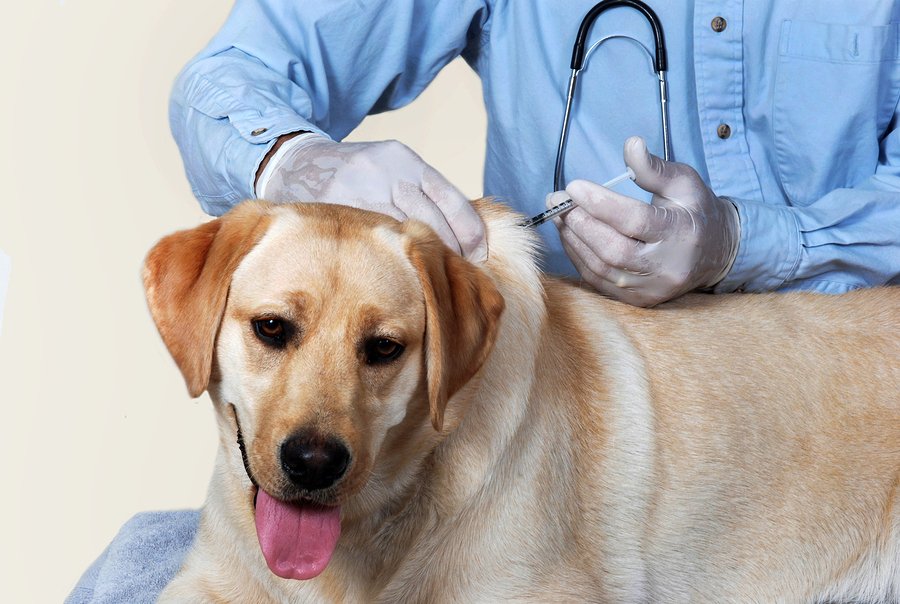
For the first time in six years, the American Animal Hospital Association (AAHA) has come out with a new set of guidelines for vaccinating dogs. And those guidelines are changing with the times. For instance, with this edition they are now produced as an online education resource that will allow ongoing updates to be made whenever new research information comes in. No longer will there be “gaps of years between versions,” says Link Welborn, DVM, DABVP, CCRT, chair of the AAHA’s Canine Vaccination Task Force. In fact, he says, “the online format will also be accessible on mobile devices, which will improve functionality greatly.”
To be sure, many of the basic guidelines remain the same. As has been the case, there are several “core” vaccines advised for virtually all dogs and also “non-core” vaccines considered useful for certain dogs living in specific environments with particular lifestyles. That is, because of the way some dogs live or where they live, they are more likely to come into contact with certain harmful bacteria and viruses that can make them very ill; therefore, those dogs make good candidates for vaccines that would inoculate them against those pathogens.
But while the core and non-core vaccines aren’t new, the approach is morphing. The guidelines for vaccines have always been seen as just that — guidelines rather than a mandate or a prescribed protocol. But that point is now being emphasized like never before. Right in the second paragraph of the very long document, it says, “the information in this website is intended as a guideline only, not an AAHA standard of care. These guidelines and recommendations should not be construed as dictating an exclusive protocol, course of treatment, or procedure. Variations in practice may be warranted based on the needs of the individual patient, resources, and limitations unique to each individual practice setting…. Because each case is different, veterinarians must base their decisions on the available scientific evidence in conjunction with their own knowledge and experience.”
We should note that in the majority of cases, your veterinarian will recommend that you go along with the guidelines. The expert task force of veterinary scientists in charge of putting them together pooled the latest and best research evidence to support the suggestions. We think that in general, going along with the guidelines is a good idea. Vaccinations given at recommended intervals have saved countless dogs over the years from preventable grave illnesses and even death.

Why Dogs’ Vaccination Schedules Should be Individualized
Still, as the science moves forward, targeting your dog’s own needs rather than including her in a blanket recommendation for dogs in general becomes more plausible. Consider, for instance, that while the general advice for adult dogs is to receive booster shots for core vaccines every three years, AAHA now says that for the core vaccines, if the levels of antibodies circuiting in the blood to fight a particular disease are high enough at three years, a veterinarian can reasonably choose to wait longer than three years to give the next booster shot. The high-enough antibody level (titer) means the previous vaccine booster is still doing its job and that a new booster at that point would be redundant.
In addition, dog owners are now consciously being brought into the equation. The new guidelines make it easier for veterinarians to work jointly with pet owners in deciding whether any non-core vaccines are advisable. How so? The new guidelines contain a “Lifestyle-Based Vaccine Calculator” that takes into consideration a dog’s age, activities, and geographic locale. If you check off the box that says your dog walks on soil where wildlife could have urinated, for instance, a leptospirosis vaccine is more likely to be recommended. Leptospirosis bacteria, which can cause a life-threatening infection that affects the liver and kidneys, can be transmitted through other species’ urine, and therefore it makes sense for dogs who play in the woods where wild animals urinate to be given the vaccine.
Herewith, an overview of the basic recommendations for adult dogs both for core and non-core vaccines. Those looking for information on vaccinating puppies and for more detail in general (like what to do if your dog is overdue for vaccinations) can surf to AAHA.org/CanineVaccineGuidelines.
That site also has state-by-state information on rabies vaccine requirements along with a page on therapeutic biologics — vaccines for dogs with diseases like melanoma, lymphoma, arthritis, and atopy (skin itchiness, usually due to allergies or other sensitivities). Tufts small animal veterinary internist Orla Mahony, MVB, DACVIM, says these cutting-edge inoculations won’t prevent those illnesses, but they could potentially help ratchet down their severity.
3 Core Vaccines for Pet Dogs
Generally speaking, adult dogs should receive booster shots against the following pathogens every three years, or at longer intervals if antibody testing is chosen and shows that there are still antibodies in the blood to fight off illness from the previous booster shot.
- Distemper virus. Distemper is a viral infection of the nervous system that can cause anything from gastrointestinal upset to pneumonia to seizures or tremors.
- Parvovirus. More common than distemper, parvovirus attacks the gastrointestinal tract and immune system, causing symptoms ranging from severe vomiting to diarrhea. It can also cause a secondary bacterial infection that spreads from the GI tract to the rest of the body, wreaking havoc on all major systems. It’s more common in puppies, but it does affect unvaccinated adult dogs, too.
- Adenovirus-2. Canine adenovirus type 2 (CAV-2) causes hepatitis, a liver disease that can lead to liver failure — and death. It is also one of the reasons dogs get what is commonly termed kennel cough. A respiratory condition, it is characterized by a dry, hacking cough and gagging accompanied by a fever, runny nose, or red, watery eyes. The disease commonly runs its course without any long term effects, but it can lead to a more serious infection, which, in addition to a dog’s risk for hepatitis, is why it is listed among the core vaccines. The vaccine does not ward off infection; it makes it significantly milder than it would have been.
AAHA says the evidence on antibody testing is strong enough for all three core vaccines. What that means is that for these three, if a test shows adequate antibody titers are present in the blood, a booster shot can wait.
Dog owners should note that antibody tests can well run to at least $150, while an actual booster shot costs less than $50 and cannot harm a dog even if it isn’t needed yet. That’s why most people opt to forego antibody blood tests.
The last core vaccine is for rabies. It is the only vaccine for companion animals required by law in most — but not all — states. But even in the exempted states, the Canine Vaccination Task Force says that “foregoing vaccination due to the age or health of the dog may not be prudent.” It recommends that the rabies vaccine be administered as a core vaccine in a manner consistent with the most current version of the “Compendium on Animal Rabies Prevention & Control.” That document, published just last year in the prestigious Journal of the American Veterinary Medical Association, reminds veterinarians that rabies is a fatal disease and that while the United States has been declared free from the rabies virus within the dog population, “there is always a risk of reintroduction.” Signs of the disease include cranial nerve deficits, abnormal behavior, paralysis, seizures, and very quickly, death. There are one-year and three-year vaccinations, and your dog’s veterinarian will discuss with you which is the version required or recommended in your state.
Non-Core Vaccines: Should Your Dog Have Them?
The advice on non-core vaccines is often regional in nature. While not necessary for dogs across the country, these vaccines may be suggested for dogs across a large geographical swath. One non-core vaccine, for the Corona virus, has been removed since the last set of guidelines came out several years ago. Corona virus causes gastroenteritis — an infection of the GI tract — but one that’s “much milder than parvovirus,” Tufts’ Dr. Mahony says. “It has never been considered all that worthwhile to vaccinate against; you’d expect a dog to be able to get through it” without an inoculation.
- Bordetella bronchiseptica. Bordetella bronchiseptica is a type of bacteria that causes kennel cough, genetically unrelated to the kennel cough virus that one of the core vaccines inoculates against. Because it’s airborne, it’s highly contagious. The vaccine for it is the one often required by boarding kennels — and that your dog may not already have been given. It is administered through nose drops rather than via injection, as that provides better immunity in the route through which the offending bacteria travel. It is sometimes given with the vaccine for the canine parainfluenza virus (see below).
- Parainfluenza virus.Parainfluenzea is also a component of what is known as kennel cough complex, which can cause pneumonia in addition to a hacking cough.
- Leptospira. Leptospirosis is a life-threatening bacterial infection that affects the liver and kidneys and is very common in New England, the West Coast, and the South. There are more than 3,000 kinds of leptospirosis bacteria, about 15 of which spell potential trouble for dogs. But the vaccine takes care of only four kinds, so even with the vaccine it’s possible for a dog to contract a leptospirosis infection. But the shot will significantly reduce the chances. For adult dogs deemed at risk, an annual booster is recommended.
- Borrelia burgdorferi. This is the type of bacteria that causes Lyme disease, and there are four different vaccines for it. Lyme disease in dogs causes essentially the same symptoms as it does in people: fever, loss of appetite, lethargy, lameness (which can be intermittent and recurring), generalized stiffness or pain, and swelling of the joints. For dogs in areas where the risk for Lyme disease is prevalent, the guideline for adult dogs is to have an annual booster. The Task Force also suggests that dogs traveling from areas where Lyme disease is not endemic to regions where it is should be considered for Lyme disease vaccination as well.
- Canine Influenza Virus-H3N8. The Task Force recommends vaccinating any dog at risk for influenza, aka the flu. In most dogs, the illness presents as nothing worse than a mild cough. But about 10 percent of dogs go on to develop life-threatening pneumonia. The vaccine doesn’t only protect against the flu and reduce the severity and symptoms if the illness does strike. It also reduces the amount of virus that is shed, making a dog less likely to spread this communicable disease to other dogs. That makes it similar to the flu vaccine for people. The American Veterinary Medical Association says the same dogs that may benefit from the kennel cough vaccine can benefit from the flu vaccine because the risks are similar — the flu tends to affect dogs who live with or engage in activities with many other dogs.
- Canine Influenza Virus-H3N2. Any dog for whom the H3N8 is deemed appropriate should also receive the H3N2 vaccine. H3N2 is a newer viral strain that only made the rounds starting around 2015, as opposed to the H3N8 virus, which appeared more than a decade ago. If a dog is vulnerable to one virus, he is vulnerable to the other. Booster shots for both vaccines should be given once a year.
- Crotalus atrox. This is the vaccine to protect against a bite from the Western Diamondback Rattlesnake, which lives in the west. (The vaccine provides no protection against venom from the Coral Snake, Water Moccasin, or Mojave Rattlesnake.) The dose of most types of vaccine is usually the same whether a dog is a Chihuahua or a Great Dane, but this is one vaccine whose dose depends upon a dog’s weight. A dog who is bitten should be taken to a veterinarian as soon as possible, vaccinated or not. The shot can make for less pain and swelling, less tissue damage, and a lower risk of death. But it does not eliminate all risk, and a dog with this snake venom in him has to be treated by a doctor with anti-venom right away. In other words, the vaccination should not provide a false sense of security that a bitten dog does not have to be treated.






It’s valuable that you elaborate on how vaccinations can help protect your dog from diseases. I want to do everything I can for the health of my new puppy, so I’m thinking about taking him to a vet to get vaccinated. I’m going to look for a good veterinarian in my area that does pet vaccinations.
It’s great that you point out that it’s important to have your puppy vaccinated in order to protect them from diseases. I want to make sure my new puppy doesn’t get sick, so I’m thinking about taking him to a veterinarian to get vaccinated. I’m going to look for a good veterinary clinic in my area that offers vaccinations for puppies.